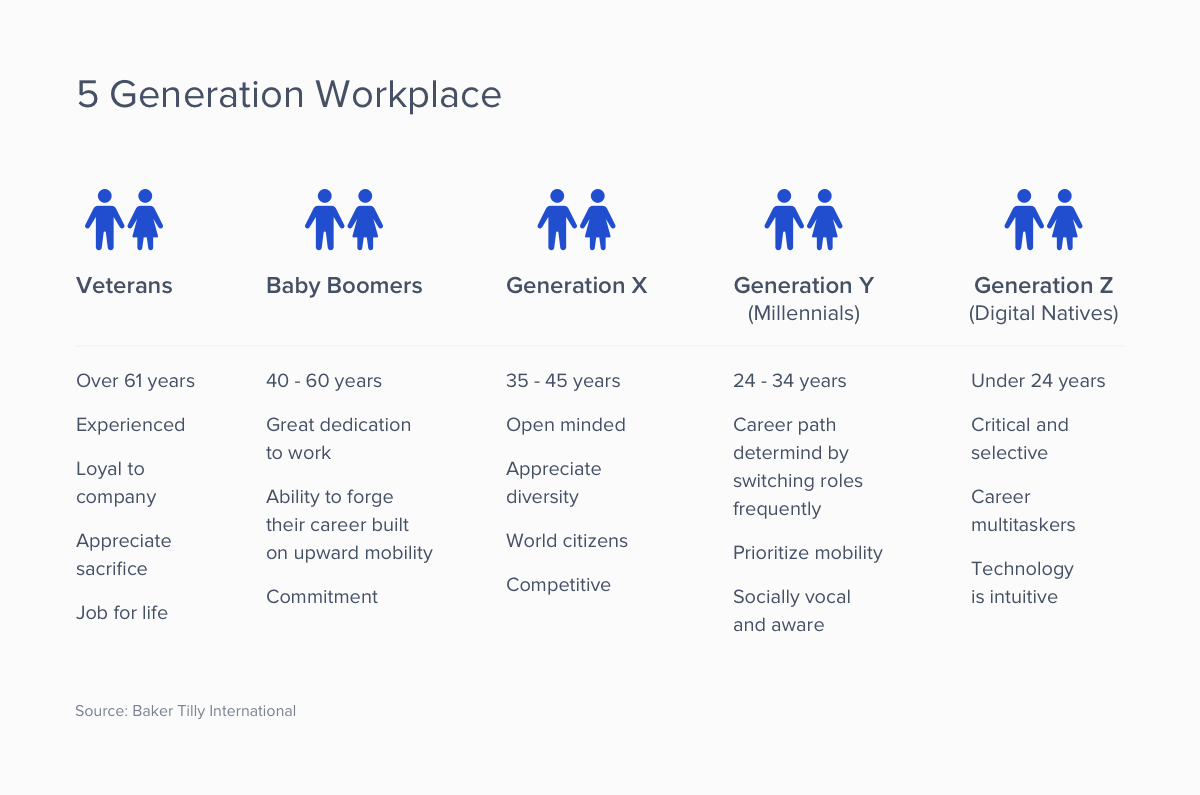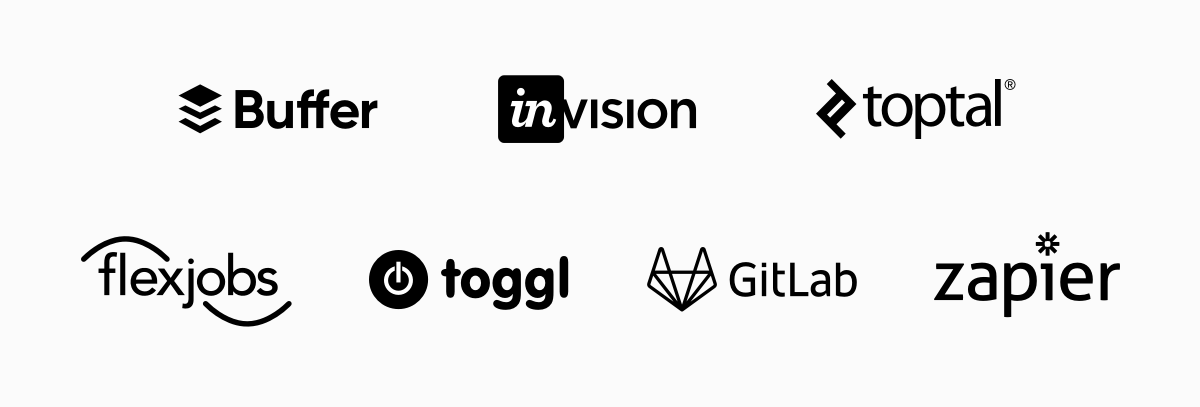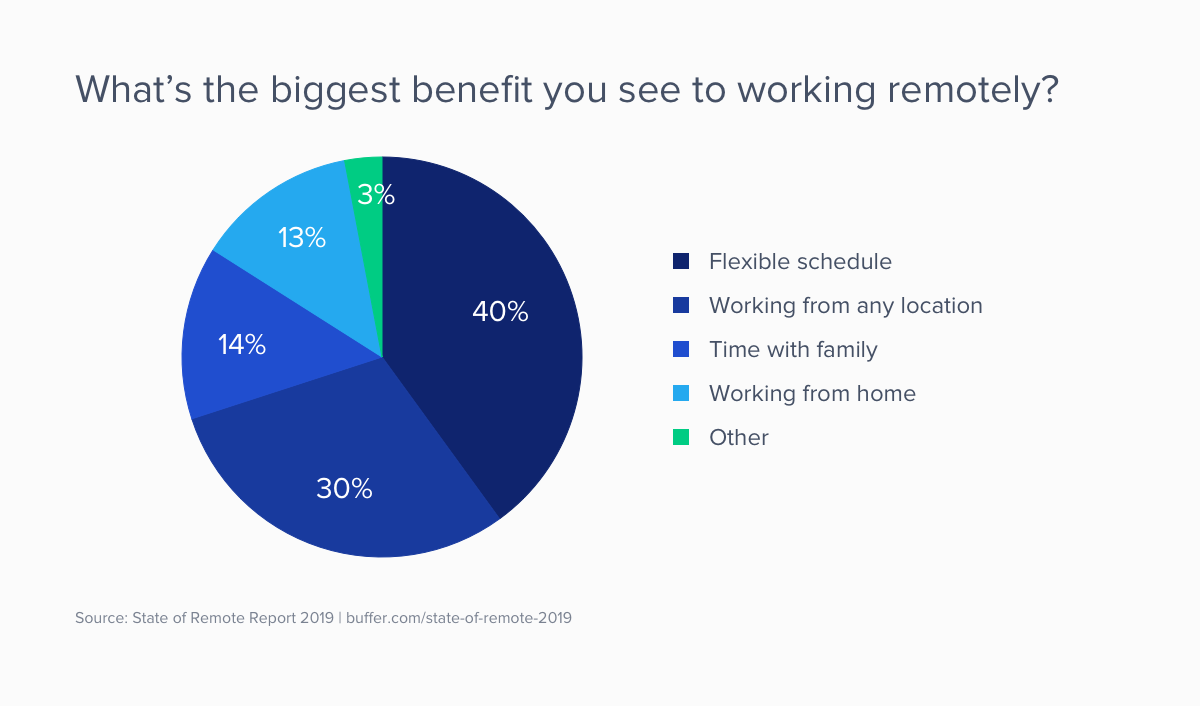No Brick, No Mortar - Remote Work is the Future
authors are vetted experts in their fields and write on topics in which they are extremely knowledgeable. All of our content is peer reviewed and validated by world-class professionals.

- In response to major social and enterprise shifts, companies are turning to remote work arrangements as a solution.
- A wealth of new technologies opens the door for companies to hire based on talent, not location.
- Forward-thinking companies push past traditional work arrangements to leverage high-quality talent rapidly and gain competitive advantages.
- Visit Staffing.com's homepage for more.
Decades ago, companies could be easily defined. They had large offices and were full of hierarchical managers and employees who clocked in at 9 every day and out at 5. The average worker was a white male who worked around 40 hours a week to support his family at home. Many companies still follow these seemingly outdated practices, much to their detriment. As Melinda Gates said,
[The modern workplace] hasn't caught up to the needs of our twenty-first century workforce and that keeps a lot of people from achieving their full potential at work and at home. If we want to make our lives better and our economy more productive that needs to change.
Today, the definition of a company is much more fluid. More organizations are shifting away from traditional work models, which means that many of the characteristics of traditional companies no longer apply. Many organizations are embracing change, diversity, and flexibility at the center of exciting new ways of working.
Catalysts and Shifts
The reason for the shift comes from a variety of factors, including the fact that people are simply tired of following the traditional 9-5 lifestyle. Although most Americans are generally satisfied in their jobs, most people hate going to work, largely because of the rigid schedule.
Quartz highlights the cultural shift this way: “Nearly eighty years after the workweek was signed into law, many things have changed. There are far more working moms today than there were in 1940. Families with young children make up two-fifths of all American families, and 61.1% of those are families where both parents are employed. It’s no longer the case that dads go off to work while moms stay home with the kids. Often both parents are pursuing careers.”
Although a set schedule may have worked decades ago, it is no longer optimal for most employees. In the US, 63% of families with children have two working parents. That number is increasing. The average commute time has never been longer, and many people prefer flexibility over hours on the road each week. With more choices of how to work, people are taking advantage of flexible schedules and freelancing. Whether they freelance on the side of a full-time job or as their career focus, the shift to freelancing has changed how people think about work. And it will have a growing impact in years to come, with the majority of employees freelancing by 2027. Even full-time employees are drawn to the flexibility of a remote schedule. In the US, 54% of full-time employees work remotely once a month, 48% work remotely at least once a week, and 30% work remotely full time.
Generational Shifts
Five generations are represented in the workforce. Traditionalists and older baby boomers are often delaying their retirements after spending decades working the traditional schedule in physical office spaces. On the other end of the spectrum are millennials and Gen Z, who tend to embrace new ideas and flexible schedules. The Pew Research Center found that younger employees are more likely to choose a flexible schedule than their older co-workers.

Finding common ground across five generations involves more than just a schedule. Other foundations of office life are also up for debate, including whether there’s a physical office at all.
Adapting to Thrive in the Future
A growing number of companies are shifting to completely remote models successfully. These fully distributed companies work in a variety of industries and bring in team members from around the world. Higher education company Kuali has employees in 23 different locations, while productivity company Time Doctor has remote employees in 28 countries. Web development company Automattic has nearly 1,000 employees, all working remotely around the world; the company is valued at $3 billion. Inherent flexibility allows these companies to pull the best talent to drive their businesses.
Co-workers may have never met each other in person, but it doesn’t stop these companies from innovating and growing. By relying on trust and digital tools, remote companies are often able to grow and pivot much more quickly than their traditional peers because they aren’t tied down to a physical space.

These innovative organizations can push even the most long-standing, traditional companies to adapt to the future. As technology, demographics, and society changes, organizations essentially have two choices: change or wait to be disrupted. In order to stay competitive, organizations must adapt.
Forward-thinking companies tend to attract top talent. Employees, especially younger generations, want to work for agile companies that help them find cohesion between their personal and professional lives. Ignoring a rapidly growing segment of the workforce means leaving behind experts that are undoubtedly critical to future success.
Digital Maturity Includes On-Demand
Adaptable companies are known as “digitally mature,” optimizing their processes to take advantage of future trends. These companies undergo digital transformations to streamline their processes and adopt seamless, forward-thinking digital solutions. They are leaders that leverage new technology for growth, both internally and externally, crafting a mindset that prioritizes constant innovation.
Digital maturity includes piloting on-demand programs. No matter their size or industry, digitally mature companies understand the need to harness experts quickly to drive initiatives.
In research published by Deloitte, the consultancy outlines seven digital pivots which digitally mature organizations embrace. One of the seven critical pivots cited is “digitally savvy, open talent networks”—organizations with high levels of digital maturity are “more than six times as likely to . . . excel at leveraging contingent/flexible labor sources,” says the report.
Hari Krishna Arya puts it this way:
Teachers will not be replaced by technology, but teachers who do not use technology will be replaced by those who do.
The same principle applies to companies and talent: companies that do not utilize on-demand models will be replaced by those who do.
Defining How We Work in the Future
What will the future of work actually entail? Here are a few central themes that will rise in prominence.
No HQ, No Office
For a growing list of companies, establishing a physical headquarters isn’t a priority anymore. For many roles and departments, virtual technologies can connect employees around the world as efficiently as a meeting room or an open-floorplan office. Some organizations are now entirely remote, while others have built hybrid environments that utilize physical and digital office spaces. The growth of cloud services and videoconferencing technology—such as Zoom, Slack, Microsoft Teams, and Trello—have enabled and bolstered momentum. According to FlexJobs, half of American employees have a job that is compatible with remote work.
Most importantly, remote policies also open the door for companies to find the best talent around the world, regardless of physical location. From an organizational perspective, this is the most critical benefit to these working models. In light of the skill/talent gap—which Gartner predicts will visibly disrupt 75% of businesses by 2020—opening access channels through remote talent models is an imperative. Organizations which limit themselves to physical-only talent interactions put themselves at a tremendous disadvantage. There’s nothing wrong with having a brick and mortar office per se, as long as the organization also has remote-work capabilities built into its operating model.
Environmental Benefits
Remote work is gaining steam as environmental issues come to the forefront. According to the EPA, 29% of greenhouse gas emissions in the US come from transportation, and office buildings are the fourth-largest contributor to greenhouse gases. In 2017, employees who worked from home avoided emitting 3.6 million tons of greenhouse gases, or the equivalent of 91 million trees to offset the emissions. Getting people off the roads and out of large buildings that often aren’t energy efficient is a step toward a more sustainable future.
Lifestyle as a Priority
Remote work offers unparalleled flexibility to employees. Workers are often faced with dividing their time between work and personal life, and the quest for the ever-elusive “work-life balance” can lead to stress and burnout. Remote work allows employees to integrate both aspects of their lives and blur the line between work and home.

Remote work also offers a way to eliminate commutes entirely. The average American employee has a daily commute of 26.9 minutes one way, which adds up to nearly 10 days a year spent driving to and from work. A study of employees in the UK found that people with long commutes are 33% more likely to suffer depression, 12% more likely to report work-related stress, and 21% more likely to be obese.
Output, Not Hours
A critique of remote companies concerns their inability to oversee what employees are doing on a daily basis. The argument is that without direct supervision in a shared office space, employees will get distracted and not be as productive. However, even a 40-hour work week in an office doesn’t actually equate to 40 hours of productivity. Most employees are only productive for around three to four hours a day, regardless of where they work.
Free from a regulated work environment, remote employees have complete control over how and when they work, which more often than not leads to an increase in productivity. Most traditional office spaces provide a single work environment for their employees—often in a cubicle with a standard-issue desk and computer. However, not everyone thrives in that environment. Remote workers can work comfortably in an environment where they feel most productive, whether that’s at the kitchen table, a shared workspace, or a home office. 77% of people say they are more productive when they work remotely.
The shift to a remote workforce also forces companies to change how they measure employee productivity. Instead of assuming that productivity comes from sitting at a desk for eight hours a day and punching a time clock, remote companies use performance-based metrics to measure employee productivity. For these companies, it’s the results and output, not the hours, that equal productivity.
From sales engagement company Groove: “We focus on output rather than time spent. We track our weekly goals closely to ensure that we’re doing what we set out to do. It keeps us all on the same page as to who’s working on what.”
Entirely remote software company GitHub takes this idea one macro-level further, measuring how well employees support the company’s long-term goals: “For us, remote doesn’t just mean location independent. We want to give people as much autonomy as possible about when and how they work. The hours people work or the tools they use aren’t that important—what matters is results.”
Prioritizing On-demand Talent
With the growth of remote full-time work, the next logical step in the evolution of work is freelancing remotely. Companies leverage freelancers for a variety of reasons, including adding to the capacity and knowledge of their current workforce. Remote freelancers offer subject-matter or project expertise without the cost of hiring a full-time employee, working through shorter contracts to fulfill the needs of the company. Their specialized skills allow organizations to hire for exactly what they need at that moment.
And by utilizing on-demand talent marketplaces—which curate highly skilled experts for remote engagements—companies are free from the time and resources needed to recruit and onboard full-time employees. It places the onus of finding quality talent on the talent provider, which allows the organization to focus its energy elsewhere.
The Ever-evolving Future
The way we work and live is drastically different than how it was even a decade ago. Shifts in demographics, society, and technology mean the future of work is likely not just a brick and mortar location. Increasingly, workers with specialized skills will be used in modular ways by organizations, assembling teams around goals and initiatives rather than staffing them to complete rote tasks. By examining the lessons these new working models offer, organizations can reevaluate outdated practices and pilot new initiatives with increasing speed.
The result? Profit, longevity, and agile capabilities that poise both small to enterprise-size organizations for future success.
